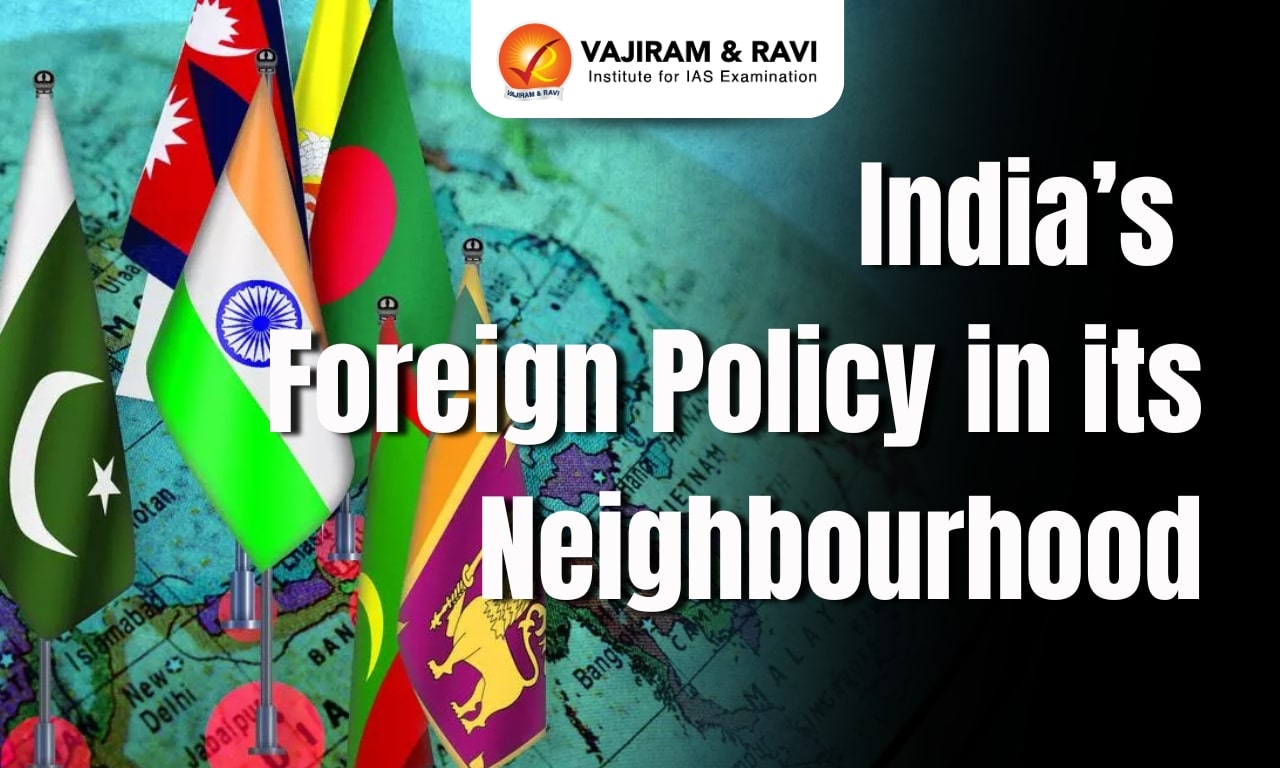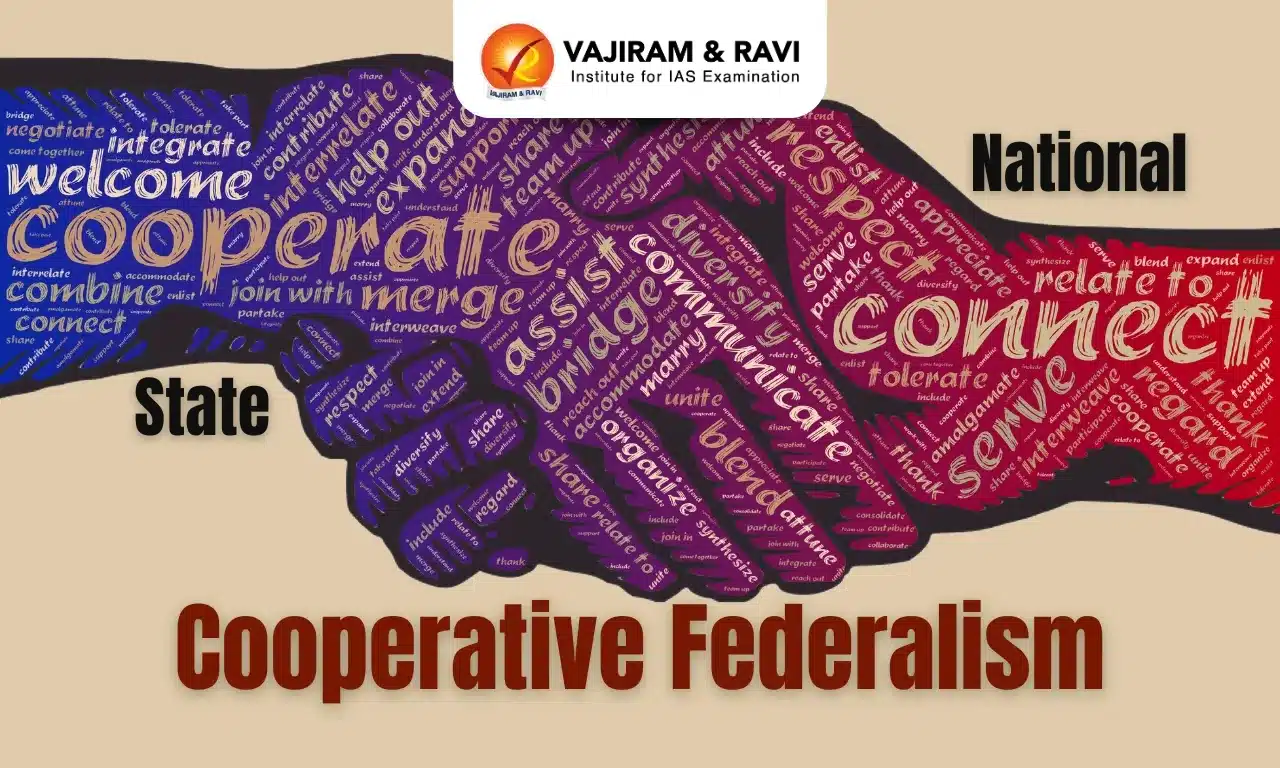Which countries comprise India’s neighbourhood?
The Indian subcontinent, as a geographical entity, has a unique character. India shares boundaries with nations greatly varying in their size, resources and strength.- The South Asian region, which is home to eight countries, and the Indian Ocean region come under the broad geographic expanse of India’s neighbourhood.
- The nations which make up India’s neighbourhood include Afghanistan, Bhutan, Bangladesh, Maldives, Pakistan, Nepal, Myanmar, Tibetan autonomous region of China and Sri Lanka.
How has India’s relations with its neighbours evolved over time?
India has a long history of cultural and commercial exchanges with its neighbours, dating back to ancient times.- British India to 1950: During colonial times, India's foreign policy was largely determined by the British government.
- Anglo-Bhutanese relations: In 1865, Bhutan was forced to surrender the passes leading to Assam to Britishers in return for an annual subsidy. Bhutan then largely remained autonomous while being a buffer state of British India.
- Anglo-Nepal relations: Nepal was an independent kingdom until the war with the Britishers in 1816. It ended with the Treaty of Sagauli that favoured the Britishers.
- Anglo-Burmese relations: The expansionist urges and the lure of forest resources of Burma resulted in three Anglo-Burmese wars. These wars resulted in the annexation of Burma into British India in 1885.
- Myanmar gained independence in 1948.
- Sri Lanka: Sri Lanka was under British rule that lasted until 1948, when the country gained independence.
- China and Afghanistan were seen as potential threats to British interests in the region and were maintained as buffer zones at the frontiers of British India.
- Pakistan was created post-independent along communal lines. This resulted in the Kashmir region becoming a point of contention between the two countries.
- 1950s and 1960s: India’s foreign policy was driven by idealism.
- Non-Alignment Movement (NAM): The policy of NAM was followed to maintain cordial relationships with all nations, including its neighbours.
- The Panchsheel (Five Principles): It was a set of principles for guiding relations between India and China.
- 1962 Indo-China war: The war was fought over disputed border territories in the Himalayan region.
- It marked a turning point in India's foreign policy as India began to re-evaluate its relationship with China.
- 1965 Indo-Pakistan war: It further entrenched the Kashmir dispute and reinforced the notion of India and Pakistan as hostile adversaries.
- 1970s and 1980s: A more assertive foreign policy was pursued during this time.
- Bangladesh liberation war: In 1971, India intervened in the Bangladesh liberation war, which led to the creation of Bangladesh.
- Southeast Association of Regional Cooperation (SAARC), 1985: It was created with the goal of promoting regional cooperation and integration among South Asian countries, with a focus on economic, social, and cultural development.
- India Sri-Lanka accord, 1987: It was signed to resolve the Sri Lankan civil war by enabling the thirteenth amendment to the Constitution of Sri Lanka.
- Operation cactus, 1988: India was involved militarily in the Maldives to foil an attempted coup.
- Post-Cold War:
- Look east policy: Launched in 1991, it aimed to strengthen economic and political ties with countries in Southeast Asia.
- Gujral doctrine, 1996: It was a set of five principles to guide the conduct of foreign relations with India’s immediate neighbours.
- Non-reciprocity with neighbours.
- Territory should not be used against the interest of another country.
- Non-interference in internal affairs.
- Respect each other’s territorial integrity and sovereignty.
- Settle all disputes through peaceful bilateral negotiations.
- Bay of Bengal Initiative for Multi-Sectoral Technical and Economic Cooperation (BIMSTEC), 1997: BIMSTEC was established as a regional organization comprising seven member states lying in the littoral and adjacent areas of the Bay of Bengal constituting a contiguous regional unity.
- Member States: Bangladesh, Bhutan, India, Nepal, Sri Lanka, Myanmar and Thailand.
- Indian Ocean Rim Association (IORA), 1997: It is an intergovernmental organization that brings together countries bordering the Indian Ocean to promote regional cooperation and economic integration.
- ‘Neighbourhood First’ policy, 2014: It aimed to strengthen relations with countries in South Asia and the Indian Ocean region.
What are the various Indian initiatives to harmonise the relations in the neighbourhood?
India has undertaken various initiatives to harmonize relations with its neighbours in the region. Some of these initiatives are- ‘Neighbourhood First’ policy: It is based on the principles of mutual respect, understanding, and sensitivity to each other's concerns and priorities.
- Act east policy: It is aimed at enhancing ties with the countries of Southeast Asia and the Asia-Pacific region.
- Connectivity initiatives: Promoting connectivity initiatives such as the international north-south transport corridor, the Chabahar port in Iran, and the Kaladan multimodal transit transport project in Myanmar.
- Development cooperation: Providing development assistance through various initiatives such as the Indian Technical and Economic Cooperation (ITEC) Program, the Indian Council for Cultural Relations (ICCR), etc.
- Vaccine diplomacy: India has played a significant role in the region's fight against COVID-19 by providing vaccines to its neighbours under its vaccine diplomacy initiative.
- Bangladesh–Bhutan– India–Nepal (BBIN) network: India is also part of the sub-regional grouping of the BBIN network.
- Country-specific initiatives:
- Bhutan: India signed the Indo-Bhutan treaty of peace and friendship in 1949 and the Agreement on cooperation in hydropower in 2006. India also provides financial support to Bhutan’s five-year plans.
- Nepal: India signed the Treaty of peace and friendship in 1950. There are various agreements related to hydropower projects like the Arun hydropower project etc.
- Sri Lanka: India is providing assistance to implement the ‘Unitary digital identity framework’. India has also been providing financial support in the face of the recent balance of payment crisis in Sri Lanka.
- Bangladesh: India has signed agreements relating to sharing of river waters with Bangladesh.
- Maldives: Greater Male connectivity project by an Indian company to provide connectivity in Maldives, restoration of Addu atolls etc.
- Myanmar: India has also been providing assistance in various fields such as education, healthcare, disaster management, capacity building and culture etc.
- Leveraging Science and Technology: India successfully launched the first-ever South Asia Satellite (SAS) to boost communication and improve disaster links among its south Asian neighbours.
What is India’s ‘Neighbourhood First’ policy?
The ‘Neighbourhood First’ policy is a foreign policy initiative introduced by India in 2014. It aims to strengthen India's relations with its immediate neighbours.- It emphasizes creating a peaceful, prosperous, and stable neighbourhood through enhanced connectivity, economic cooperation, and people-to-people exchanges.
- Principles of ‘Neighbourhood First’ policy
- Sovereignty and territorial integrity
- Mutual respect and sensitivity
- Non-interference in internal affairs.
- Shared prosperity
- Connectivity for regional integration
- People-to-people exchanges
- In 2014, the Prime Minister(PM) invited all heads of state from South Asia to his oath-taking ceremony.
- Stronger ties with Afghanistan: PM Narendra Modi went to visit Afghanistan in 2015 and inaugurated the Afghan Parliament, which was made with the help of India.
- He visited Afghanistan again in 2016 to inaugurate the Salma Dam in Herat.
- Ties with Nepal: PM Modi was the first Indian PM to visit Nepal after 17 years in 2014.
- Ties with Bangladesh: PM Modi visited Bangladesh in 2015, where India and Bangladesh exchanged instruments of ratification regarding the agreement on the historic land boundary.
- BBIN: BBIN Motor Vehicle Agreement for the regulation of passenger, personal and cargo vehicular traffic amongst BBIN members was signed in 2015.
- Vaccine Maitri: India, through its vaccine diplomacy, extended help on priority to its neighbours during the Covid-19 pandemic
What are the challenges in India’s relations with its neighbours?
India's relations with its neighbours have been marked by a range of challenges and issues over the years.- Border disputes: India has long-standing border disputes, particularly with China (Line of Actual Control) and Pakistan (Line of Control), which have led to military conflicts and tensions.
- Terrorism: India has been a victim of terrorism perpetrated by groups based in neighbouring states, especially Pakistan.
- Competition from China: India's growing geopolitical and economic influence in the region has led to competition with China. This has led to tensions over issues such as trade and investment.
- Most of the countries in India’s neighbourhood are part of China’s belt and road initiative, with the exception of Bhutan.
- Water sharing: India shares rivers with several of its neighbours like Bangladesh, Pakistan, and Nepal, and water sharing has been a source of tension over the allocation and use of water resources, which has led to disputes.
- Example: Disputes over the Indus water treaty with Pakistan
- Political instability: Several of India's neighbours have experienced political instability and internal conflicts, which has had an impact on regional stability and security.
- Example: Military coup in Myanmar in 2021
What steps can be taken to strengthen India’s relations with its neighbours?
- Economic cooperation: By increasing trade, investment, and cross-border connectivity. (South Asia’s intra-regional trade is the lowest globally, constituting only 5% of the region’s total trade).
- People-to-people exchanges: India can promote people-to-people exchanges by facilitating cultural, educational, and tourism exchanges.
- Security cooperation: India can strengthen security cooperation with its neighbours to address common security challenges such as terrorism, cyber threats, and transnational crime. SAARC and BIMSTEC frameworks can play an important role in this.
- Regional integration: India can support regional integration by participating actively in regional forums such as SAARC, BIMSTEC, and IORA.
- Diplomatic outreach: India should engage in sustained diplomatic outreach to its neighbours to promote dialogue, resolve outstanding issues, and build mutual trust.
Last updated on November, 2025
→ Check out the latest UPSC Syllabus 2026 here.
→ Join Vajiram & Ravi’s Interview Guidance Programme for expert help to crack your final UPSC stage.
→ UPSC Mains Result 2025 is now out.
→ UPSC Notification 2026 is scheduled to be released on January 14, 2026.
→ UPSC Calendar 2026 is released on 15th May, 2025.
→ The UPSC Vacancy 2025 were released 1129, out of which 979 were for UPSC CSE and remaining 150 are for UPSC IFoS.
→ UPSC Prelims 2026 will be conducted on 24th May, 2026 & UPSC Mains 2026 will be conducted on 21st August 2026.
→ The UPSC Selection Process is of 3 stages-Prelims, Mains and Interview.
→ UPSC Result 2024 is released with latest UPSC Marksheet 2024. Check Now!
→ UPSC Prelims Result 2025 is out now for the CSE held on 25 May 2025.
→ UPSC Toppers List 2024 is released now. Shakti Dubey is UPSC AIR 1 2024 Topper.
→ UPSC Prelims Question Paper 2025 and Unofficial Prelims Answer Key 2025 are available now.
→ UPSC Mains Question Paper 2025 is out for Essay, GS 1, 2, 3 & GS 4.
→ UPSC Mains Indian Language Question Paper 2025 is now out.
→ UPSC Mains Optional Question Paper 2025 is now out.
→ Also check Best IAS Coaching in Delhi
India’s Foreign Policy in its Neighbourhood FAQs
Q1. What is Non-Alignment Movement?+
Q2. What is the Kaladan multimodal project?+
Q3. What is Indus Water Treaty?+

















